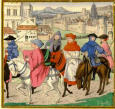









|
3. The Canterbury Tales
Introduction
 The Canterbury Tales, generally considered to be Chaucer’s masterpiece,
is his great literary accomplishment, a compendium of stories by pilgrims
traveling to the shrine of Thomas à Becket in Canterbury. Chaucer introduces
each of these pilgrims in vivid brief sketches in the General Prologue and
intersperses the twenty-four tales with short dramatic scenes with lively
exchanges. The work was left unfinished upon the death of Chaucer.
The Canterbury Tales, generally considered to be Chaucer’s masterpiece,
is his great literary accomplishment, a compendium of stories by pilgrims
traveling to the shrine of Thomas à Becket in Canterbury. Chaucer introduces
each of these pilgrims in vivid brief sketches in the General Prologue and
intersperses the twenty-four tales with short dramatic scenes with lively
exchanges. The work was left unfinished upon the death of Chaucer.
The work begins with the general prologue in which the narrator arrives at
the Tabard Inn in Southwark, and meets other pilgrims there. In the second
part of the the general prologue the inn-keeper proposes that each of the
pilgrims tell stories along the road to Canterbury, two each on the way
there, two more on the return journey, and that the best story earn the
winner a free supper.
Since there are some thirty pilgrims, this would have given a collection of
well over a hundred tales, but in fact there are only twenty-four tales, and
some of these are incomplete. Between tales, and at times even during a
tale, the pilgrimage framework is introduced with some kind of exchange,
often acrimonious, between pilgrims. In a number of cases, there is a longer
Prologue before a tale begins, The Wife of Bath’s prologue and the
Pardoner’s prologue being the most remarkable examples of this.
The General Prologue
The General Prologue has usually been seen as the most important part of the
whole poem. The narrator opens the General Prologue with a description of
the return of spring. He describes the April rains, the burgeoning flowers
and leaves, and the chirping birds. Around this time of year, the narrator
says, people begin to feel the desire to go on a pilgrimage. Many choose to
travel to Canterbury to visit the relics of Saint Thomas àBecket in
Canterbury Cathedral. The narrator meets a great company of twenty-nine
travelers at a tavern in Southwark called the Tabard Inn near London. The
travelers were a diverse group who, like the narrator, are on their way to
Canterbury.
They happily agree to let him join them. That night, the group slept at the
Tabard Inn, and woke up early the next morning to set off on their journey.
Before continuing the tale, the narrator declares his intent to list and
describe each of the members of the group: Knight, Squire, Yeoman, Prioress,
Monk, Friar, Merchant, Clerk, Man of Law, Franklin, Haberdasher, Carpenter,
Weaver, Dyer, Tapestry-Weaver, Cook, Shipman, Physician, Wife, Parson,
Plowman, Miller, Manciple, Reeve, Summoner, Pardoner, and Host. In order to
pass away the fatigue hours, they agree that each pilgrim will tell two
stories on the way to Canterbury and two on the way back. Whomever he judges
to be the best storyteller will receive a meal at Bailey’s tavern. The
pilgrims draw lots and determine that the Knight will tell the first tale.
The General Prologue is usually regarded as the greatest portrait gallery in
English literature. It is largely composed of a series of sketches differing
widely in length and method, and blending the individual and the typical in
varying degrees. The purpose of the General Prologue is not to present a
vivid collection of the character sketches, but also tries to reveal the
author’s intention in bringing together a great variety of people and
narrative materials to unite the diversity of the tales by allotting them to
a diversity of tellers engaged in a common endeavor, to set the tone for the
story telling—one of jollity which accords with the tone of the whole work:
that of grateful acceptance of life, to make clear the plan for the tales,
to motivate the telling of several of the tales and to introduce the
pilgrims and the time and occasion of the pilgrimage. With ranging the
pilgrims in status from a Knight to a Plowman, Chaucer presented a microcosm
of the14th century English society.

|
![]()
![]()